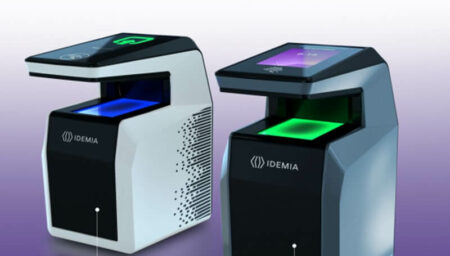Delivering frictionless access everywhere with the MorphoWave range

These powerful biometric devices verify identity in one second, with zero contact, and demand next to nothing from users. The latest generation algorithms embarked in these devices are powered by Artificial Intelligence, ensuring the highest level of performance, both in terms of security and speed.
The vast majority of companies today use ID badges as a form of “access control”. An employee swipes their badge to gain entry in the building lobby, elevator or a restricted room. But without biometric verification, these badges don’t actually control access. When we consider how easily a badge can be lost, stolen or simply loaned to a colleague, it’s clear that badges don’t add any real element of identification and security, but only helps to monitor the flow of people. The only way to truly control access is by integrating biometrics – the fingerprint or the face of the employee becomes their own badge and the organization can be certain that the person entering is authorized to do so. In other scenarios, this level of certainty becomes even more essential to the end-users themselves, when it grants access to their homes – a booming trend in South Africa, Brazil and the United States.
In the past, adding this extra layer of security unavoidably meant slowing down access. With single fingerprint sensors, verification can take up to several seconds – a non-issue for granting access to a dozen employees to a highly restricted area, but a significant hurdle when hundreds of employees arrive at work at the same time.
When we add convenience and speed to the equation, on top of security and hygiene, contactless biometric authentication is the only reliable choice. The latest contactless fingerprinting technology captures fingerprint data of all four fingers from several different angles within one second and rely on high-performance algorithms to verify the person’s identity. These devices can grant access to as many as 50 users per minute.
Similarly, leading facial recognition devices use state of-the-art optical set of 2D, 3D and infrared cameras to capture all angles of a person’s face. With a simple glance, access is granted – regardless of lighting conditions, user’s heights, angle or various changes to a person’s appearance (hat, beard, glasses, etc.).
As biometrics use becomes more commonplace (in airports, office buildings or even residential buildings) an ever increasing number of users will have the chance to experience contactless biometrics at work—as long as they are willing to do so, and in the framework of applicable privacy and data protection regulations of course.
An added, and very timely bonus of contactless biometrics? These users can breathe a sigh of relief as they effortlessly scan their faces or fingertips without needing to touch the same glass panel touched by thousands (or millions) just before.